Temporary field storage of non-agricultural source material
Learn to determine if, and for how long, non-agricultural source material can be stored in a specific temporary field storage site. This technical information is for Ontario producers.
ISSN 1198-712X, Published January 2016
Introduction
As of January 1st, 2011, the land application and some on-farm storage of Non-Agricultural Source Material (NASM) is regulated under Ontario Regulation 267/03, as amended (the “Regulation”), which is made under the Nutrient Management Act, 2002 (NMA). If a material is to be stored at an agricultural operation under a NASM plan for more than 24 hours, it must be kept in either a permanent nutrient storage facility or a temporary field nutrient storage site.
Some types of NASM can be temporarily stored at a field prior to application if a number of regulatory requirements are met. These regulatory requirements take into account the characteristics of the material and the characteristics of the temporary field storage site. This information is used to determine if, and for how long, the NASM can be stored in a specific temporary field storage site.
Characteristics of the material
Only material meeting the definition of "solid" in Section 1 of the Regulation can be stored in a temporary field storage site. Solid, in relation to prescribed materials or nutrients, is defined as: "... having a dry matter content of 18%, or more, or a slump of 150 mm, or less, using the (slump test) set out in Schedule 9 to Regulation 347 made under the Environmental Protection Act...".
Temporary storage of liquid NASM
Liquid NASM cannot be stored in a temporary field nutrient storage site. Liquid NASM can, however, be stored in portable tanks at the field prior to/during application if the following rules in section 81.3 of the Regulation are met:
- The capacity of the tank cannot exceed the amount of material that will be applied to the NASM application area in 1 day.
- All the material that is delivered to the application site must be applied by midnight of the day the material is received.
- The portable tanks must be empty by midnight of the day of application.
Odour
NASMs have been divided into three categories based on odour detection thresholds. Table 1 is a summary of the odour categories and examples of materials that fit into each category. Solid NASM that is OC3 cannot be put into temporary field storage.
| Category | Definition | Example materials* |
|---|---|---|
| Odour Category 1 (OC1) | Odour detection threshold of <500 odour units/m3 |
|
| Odour Category 2 (OC2) | Odour detection threshold of ≥500 to <1,500 odour units/m3 |
|
| Odour Category 3 (OC3) | Odour detection threshold ≥1,500 to <4,500 odour units/m3 |
|
*A complete list of NASMs and their odour category can be found in the Nutrient Management Tables.
Note: Material with >4,500 odour units/m3 cannot be land-applied to agricultural land.
Location of temporary field storage sites
If solid NASM is stored in a temporary field storage site for longer than 24 hours, the site must meet all the requirements shown in Table 2.
| Minimum site requirements | Rationale |
|---|---|
| The minimum depth of unconsolidated soil |
This minimizes the potential for runoff to reach bedrock under, or near, a temporary storage site. |
| The minimum depth of soil above the water table |
This minimizes the potential for runoff to reach the water table under, or near, a temporary storage site. |
| Nutrients must not be stored on soils whose hydrological soil group is A, unless the depth to soil is greater than 0.9 m to bedrock. | “Hydrologic soil group A” means a soil with rapid infiltration rates, as defined by the Drainage Guide for Ontario. There are very few locations in Ontario with both hydrologic soil group A and shallow soils, but if you suspect your farm is situated on one of them, use a metal rod to probe down at least 1 m to check for possible shallow bedrock. |
| The storage site must not be located in an area that, according to the flood plain mapping provided by the municipality or conservation authority, is subject to flooding more than once every 100 years. | Storage sites with the potential for flooding are inappropriate. Ask the conservation authority if they have records indicating that the proposed temporary storage is in a 1-in-100-year flood plain. |
| The site must not have a slope greater than 3%. | 3% is a vertical drop of 3 m every 100 m distance, however, slope should be calculated over a minimum length of 10 m. Runoff moves quickly on relatively steep slopes. |
| There must be a flow path that is at least 50 m to the nearest surface water or tile inlet and located at least 0.3 m above bedrock. | Flow path is defined in the Regulation as “a surface channel or depression that conducts liquids away from the area.” |
Setbacks from wells are:
|
Setbacks help minimize risks to drinking water. Setbacks to wells are greater than those required for permanent storages since there is more risk of runoff. |
| Setbacks from dwelling, residential area OC1 NASM:
|
Setbacks help minimize odour issues with neighbours. Setbacks from OC2 NASM storage sites are greater because these materials have a higher odour potential. |
Management requirements for temporary field storage sites
The Regulation sets out the minimum management requirements for field sites used to temporarily store solid NASM. These requirements are summarized in Table 3.
| Minimum management requirements | Rationale |
|---|---|
| A farmer who receives and stores NASM on site cannot receive and store more NASM than is expected to be used for crop production on that farm unit in that operating year. | Storage piles should be size-appropriate for the field; a temporary pile is truly temporary when it is used on the field where it is placed. |
| NASM stored on the site must be used on the farm unit and cannot be transferred to another farm unit. | To limit risk, NASM in temporary field storage must be applied to the farm unit it is stored on. It cannot be stored on one farm unit and then transferred and spread on another. |
| If more than one type of NASM is stored on site, the nutrients must be managed in accordance with the most restrictive requirements applicable to any of the NASM stored in the site. | If more than one type of NASM is stored at a site, it is very hard to determine the make-up of the combined material. Therefore, requirements for the material that is most restrictive apply to all the material stored at the site. |
| If the site is located in an area that is tile-drained, there must be a contingency plan in place to deal with any contaminated liquid that might get into the tiles. | Landowners must be prepared to deal with runoff getting into tile drains. Proving there are, or aren’t, tiles under or near a temporary storage can be difficult. Some ideas include: checking aerial photos of the field; looking for nearby tile outlets; observing the first spots to drain in spring; or asking previous owners and local drainage contractors. Probing at least 1 m deep in more obvious locations for tiles with a metal rod can help but is difficult over large areas. |
| NASM must not be stored on site for longer than the maximum time allowed for each nutrient. | If you have more than one temporary field storage on the farm in different locations, each one might have a different allowable maximum time at that site based on the scoring system for that site. |
| The site may be used again the following year if a minimum of 75% vegetative cover is re-established on the site following the removal of NASM from the surface after the site ceases to be in use each year. | To be used consecutively for temporary field storage, the area must be able to grow vegetation again. This can be difficult when the same site is used annually. |
Determining the length of solid NASM storage allowed at a site
Table section 4 sets out 10 site characteristics and management practices that can be used to determine the number of allowable days of temporary storage. The table explains how each factor is used to cumulatively determine the maximum allowable time of field storage at each site and the rationale. The storage period is linked to relative environmental risk to surface and groundwater.
The total number of days is cumulative but cannot exceed 300 days. Dewatered municipal sewage biosolids have additional restrictions. No matter what the site characteristics or management practices are, municipal dewatered sewage biosolids that are OC2 cannot be stored for more than 10 days in temporary field storage.
Table section 4. Temporary field storage of NASM site-scoring system used to determine allowable days of storage.
4.1: % Dry matter
| Management techniques and field conditions | Allowable days of storage |
|---|---|
| Nutrients stored in the site have a dry matter content of 50%, or more | +60 |
| Nutrients stored in the site have a dry matter content of 30% or more, but less than 50% | +30 |
| Nutrients stored in the site have a dry matter content of 18%, or more, but less than 30% (includes horticultural culled materials) | +0 |
Rationale: The higher the dry matter % of the material, the more rainfall it can soak up. Wetter material sheds rainfall off the sides, or lets it soak through and into the soil. Keeping the top of the pile as flat as possible allows rainfall to soak in, preventing runoff (Figure 1).
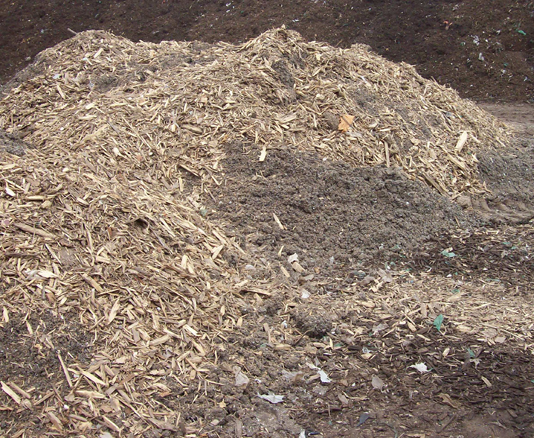
4.2: % N and % P added together
| Management techniques and field conditions | Allowable days of storage |
|---|---|
| The % of total nitrogen combined with the % of total phosphorus, both on a wet basis, is less than 0.8% | +60 |
| The % of total nitrogen combined with the % of total phosphorus, both on a wet basis, is at least 0.8%, but less than 1.6% | +30 |
| The % of total nitrogen combined with the % of total phosphorus, both on a wet basis, is 1.6%, or more | +0 |
Rationale: Nitrogen and phosphorus are two nutrients that have environmental risk. The lower the content of these two nutrients in the stored NASM, the lower the environmental risk of runoff. There is a broad range of nutrient contents in solid NASM (Figure 2).
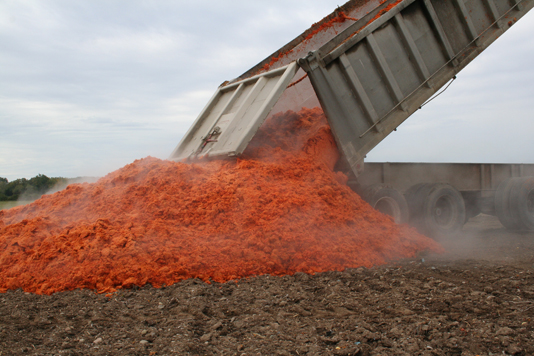
4.3: Drainage tile and bedrock location
| Management techniques and field conditions | Allowable days of storage |
|---|---|
There are no field drainage tiles at any depth of the soil surface and no bedrock within 0.9 m of the soil surface, located:
|
+0 |
There are field drainage tiles at any depth of the soil surface or bedrock within 0.9 m of the soil surface, located:
|
–60 |
Rationale: Field tiles and/or bedrock are direct conduits that allow runoff from temporary storage piles to enter surface or groundwater.
There is less environmental risk if the area chosen to build a temporary storage pile does not have bedrock or tile drains under, near, or in the first part of the flow path away from the pile (Figure 3).
Most Ontario farms are tiled, and many have bedrock near the surface. It is natural to assume this is a good place to store material, since it is a dry place for machinery. However, the Regulation encourages operators to avoid these locations by “taking away” days of storage on sites with these conditions.
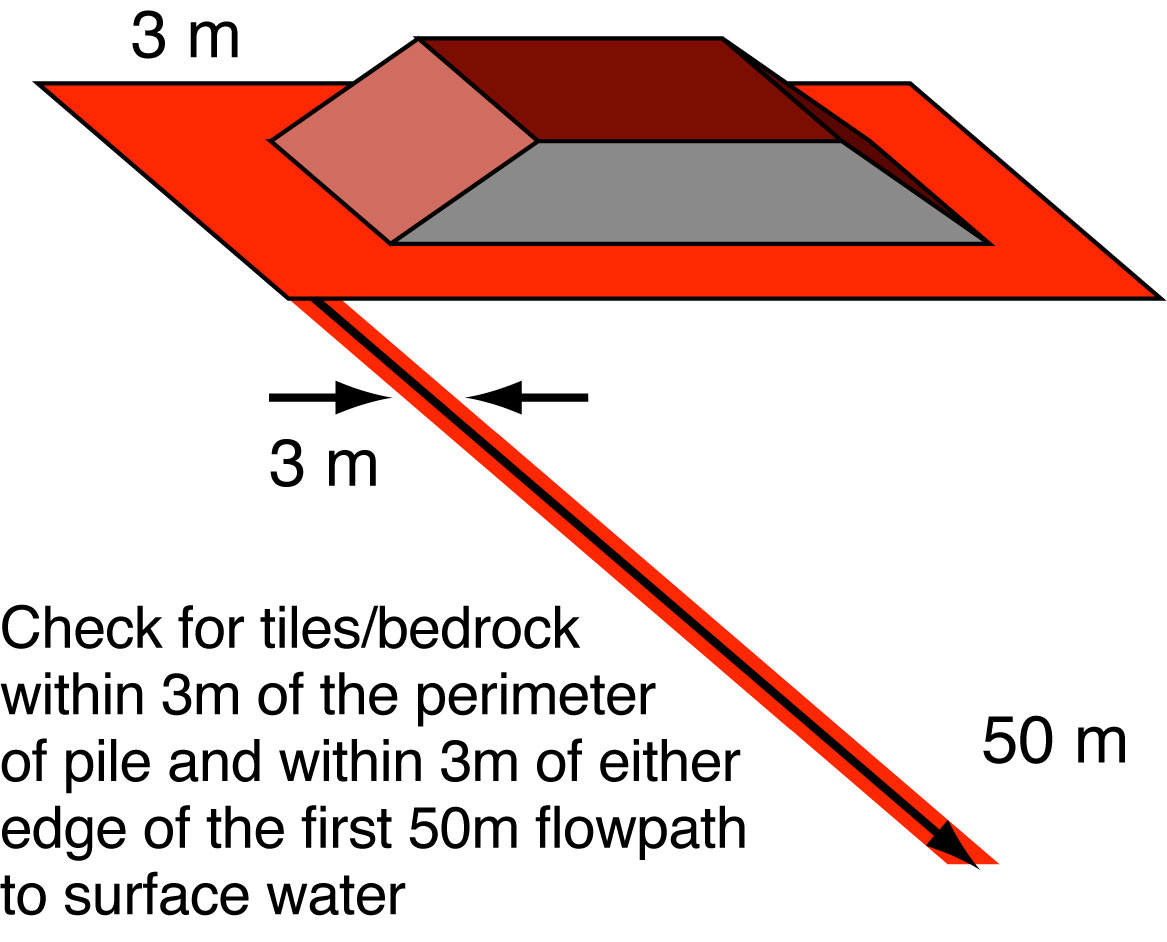
4.4: Soil type under the site
| Management techniques and field conditions | Allowable days of storage |
|---|---|
| The site is situated on soil included in the following hydrologic soil groups as defined by OMAFRA Publication 29, Drainage Guide for Ontario: B, C or D | +30 |
| The site is situated on soil included in the following hydrologic soil groups as defined by OMAFRA Publication 29, Drainage Guide for Ontario: A | +0 |
Rationale: The heavier the soil under a temporary field storage, the less opportunity there is for leachate to percolate to the groundwater. Clay soils are denser and better at preventing downward percolation than lighter, coarser soils one might find in a peach orchard (Figure 4).
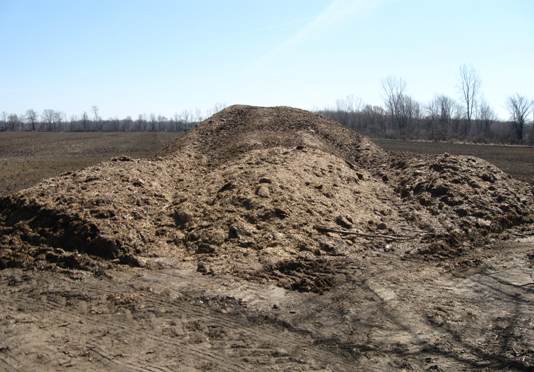
4.5: Perimeter of the site
| Management techniques and field conditions | Allowable days of storage |
|---|---|
| The outer edge of the site (of all piles), at the ground surface, has a perimeter of less than 100 m | +30 |
| The outer edge of the site (of all piles), at the ground surface, has a perimeter of 100 m, or more | +0 |
Rationale: Piles that have a more square and compact footprint will soak up more rainfall than piles of equivalent volume that are long and narrow, since they have less total perimeter for runoff. This table shows the perimeter of three pile types, all storing 100 tonnes of solid NASM, stored 1.2 m deep (4 ft) when dumped from a truck; one long and narrow, one medium length, and one short and wide pile.
4.6: Covers and tarps
| Management techniques and field conditions | Allowable days of storage |
|---|---|
The site is covered with a rain-shedding tarp that:
|
+120 |
| The site is not covered with rain-shedding tarp. | +0 |
Rationale: Tarps prevent contaminated runoff, since rainfall does not touch the material. However, tarps are unpopular because they are inconvenient and difficult to anchor against wind removal (Figure 5).
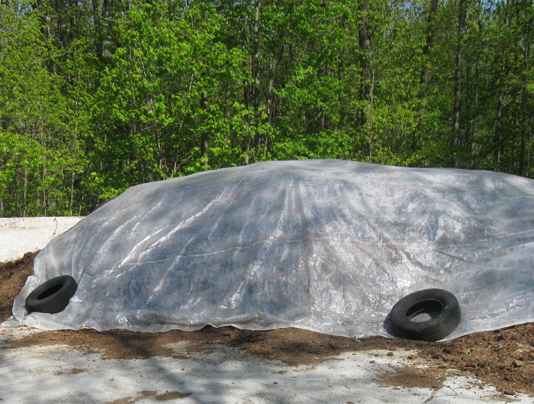
4.7: Distance to surface water
| Management techniques and field conditions | Allowable days of storage |
|---|---|
| The site has a flow path to the nearest surface water or water inlet for field tile drainage of 150 m, or more | +30 |
| The site has a flow path to the nearest surface water or water inlet for field tile drainage of at least 50 m, but less than 150 m | +0 |
Rationale: If runoff does occur, there is less environmental risk if the runoff has to travel a long distance to surface water or to a water inlet for field tile drains. Surface water is defined in the Regulation. Although water inlets for field tile drains are not surface water under the Regulation, temporary field storages should not be located near them (Figure 6).
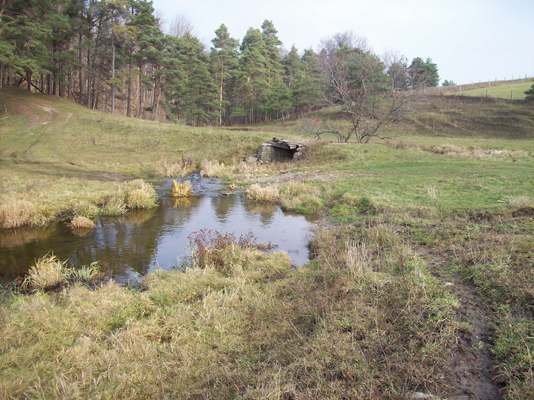
4.8: Location of the site
| Management techniques and field conditions | Allowable days of storage |
|---|---|
| The site is situated on the same location, or within 125 m of the same location not more often than once every 3 years | +60 |
| The site is situated on the same location, or within 125 m of the same location more often than once every 3 years | +0 |
Rationale: Temporary field storage in the same location year after year is considered permanent storage (Figure 7). Storage in one area causes a build-up of nutrients in the soil that may leach to groundwater or harm crops that are grown in the area in the future. Piles should be sized appropriate to fields, and moved from field to field, as needed, for each crop.

4.9: Materials removed from site
| Management techniques and field conditions | Allowable days of storage |
|---|---|
| The site is not situated on the same location, or within 125 m of the same location, more often than once every 3 years, and the materials stored are removed from the site and applied to land between August 15th and October 15th in any year. | +60 |
| The situation described above does not apply to the site. | +0 |
Rationale: Many farmers want to spread NASM between mid-summer and early fall, such as after wheat is harvested. Usually, during this time, more moisture evaporates than is replaced by rainfall, so there is reduced risk of runoff. The Regulation provides an incentive for temporary field-stored NASM that will be spread during this drier period, as long as different sites are chosen each year (Figure 8). The period of August 15th to October 15th corresponds to the time of year that a cover crop can be planted on the field to reduce the risk of environmental loss of nutrients from the NASM.
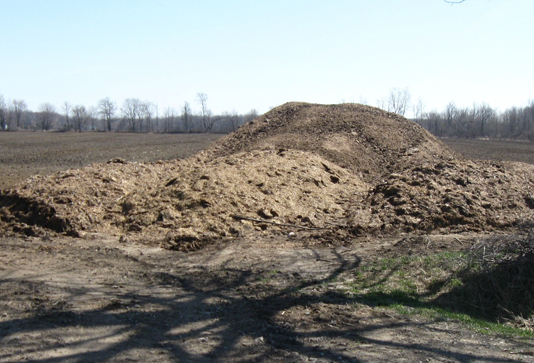
4.10: Turning of stored materials
| Management techniques and field conditions | Allowable days of storage |
|---|---|
The pile of materials stored on site:
|
+120 |
| The site described above does not apply. | +0 |
Rationale: An increasing number of operators compost their solid material for use on cropland, as shown here. Long windrows of material with a high carbon source, such as straw or wood shavings, are placed in the field, and then turned on a regular basis to mix and introduce oxygen into the pile (Figure 9). This improves the compost process, removes moisture from the piles and breaks up surface crusting, allowing the piles to act as sponges for any rainfall that lands.
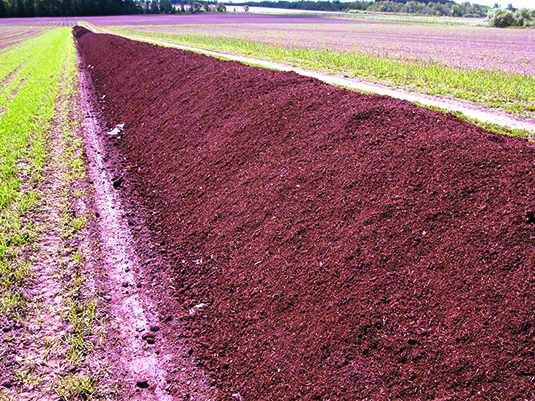
Records
The Regulation requires records to be kept when using temporary field storage. The records must include:
- the date the pile was established
- the date the material was removed from the pile
- the date(s) the pile was turned, if the management of the material includes the turning of the pile. See Table 4.10.
- a sketch showing the location of the site relative to the required setback distances shown in Table 2, and distance to any other temporary field storage sites
- management techniques and site conditions used in calculating the allowable days of storage. Be able to show how the allowable days of storage were calculated.
Examples
The following two examples show how allowable days of storage are calculated for different types of material.
Example 1
For this example, a temporary field storage of culled onions from a food processor has these characteristics:
| # | Characteristics | Example 1 | Days |
|---|---|---|---|
| 1 | % dry matter |
13% | +0 |
| 2 | % N added to % P | 0.25% | +60 |
| 3 | Tiles/bedrock under/nearby | none | +0 |
| 4 | Soil type | clay (D) | +30 |
| 5 | Perimeter of pile | 30 m | +30 |
| 6 | Cover | none | +0 |
| 7 | Distance to surface water | 500 m | +30 |
| 8 | Location of site | once/3 years | +60 |
| 9 | Removal date | May | +0 |
| 10 | Turning of pile | not turned | +0 |
Based on these characteristics, total maximum days allowed at this site is +210 days.
In this example, the producer could increase the allowable days of storage by covering the pile or removing the material between August 15th and October 15th. No matter what the characteristics for the site, material cannot be stored for more than 300 days (Figure 10).
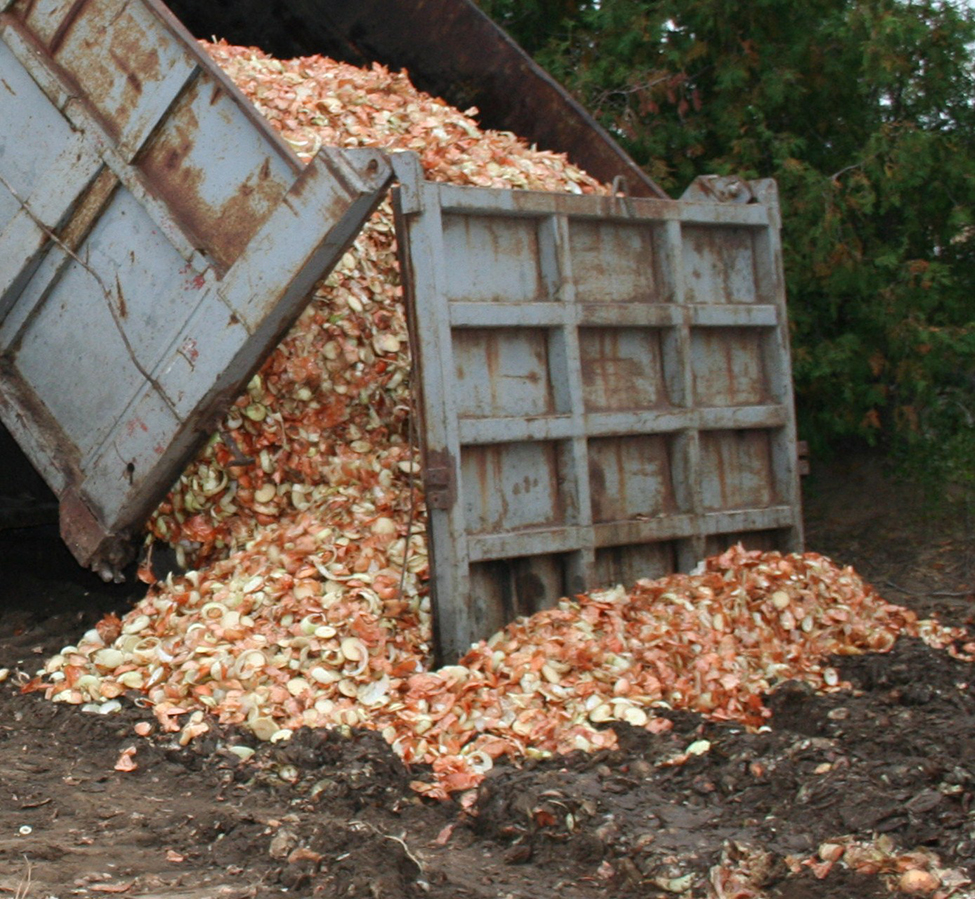
Example 2
Pulp and paper biosolids are the solid residues from the treatment of wastewater from pulping, papermaking and paper recycling operations. A temporary field storage for pulp and paper biosolids has these characteristics:
| # | Characteristics | Example 2 | Days |
|---|---|---|---|
| 1 | % dry matter | 40% | +30 |
| 2 | % N added to % P | 0.55% | +60 |
| 3 | Tiles/bedrock under/nearby | tile present | –60 |
| 4 | Soil type | sand (A) | +0 |
| 5 | Perimeter of pile | 50 m | +30 |
| 6 | Cover | none | +0 |
| 7 | Distance to surface water | 75 m | +0 |
| 8 | Location of site | every year | +0 |
| 9 | Removal date | September |
+0 |
| 10 | Turning of pile | not turned | +0 |
Based on these characteristics, total maximum days allowed at this site is +60 days.
In this example, a producer could increase the allowable storage time by finding a site without tiles, by moving it farther from surface water or by moving to different locations every year in a crop rotation and continuing to spread in September (Figure 11).
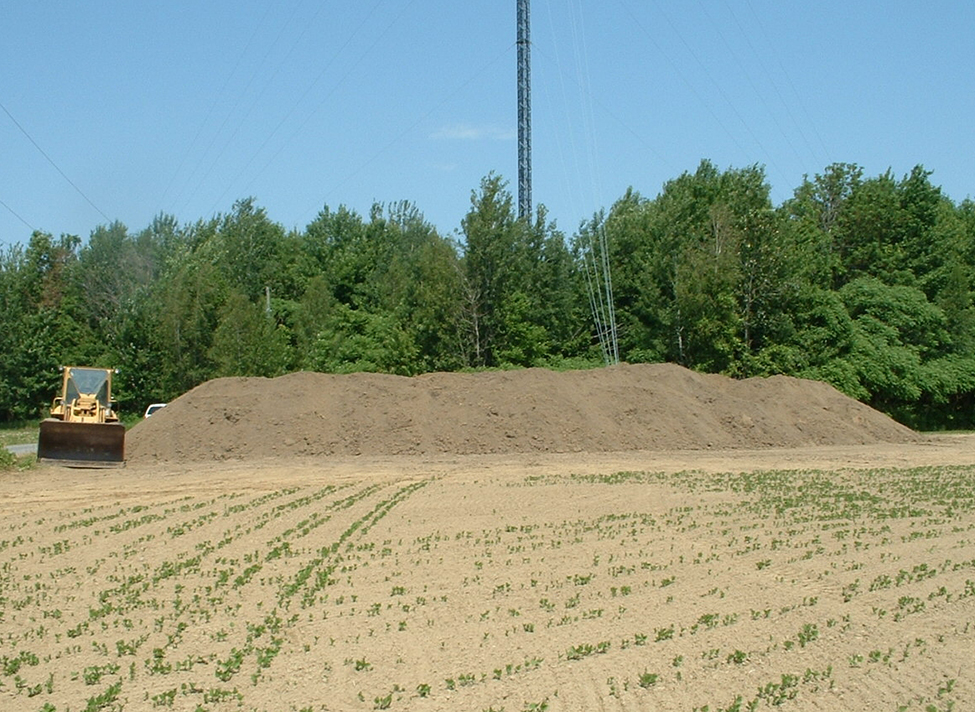
Nutrient management disclaimer
The information in this fact sheet is provided for informational purposes only and should not be relied upon to determine legal obligations. To determine your legal obligations, consult the relevant law. If legal advice is required, consult a lawyer. In the event of a conflict between the information in this fact sheet and any applicable law, the law prevails.
This fact sheet was originally written by Hugh Fraser (retired), P. Eng., horticultural crop protection and post-harvest engineer, OMAFRA and revised by Matt Wilson, environmental specialist, OMAFRA and Trevor Robak, environmental specialist, OMAFRA.
Footnotes
- footnote[1] Back to paragraph Unconsolidated soil has not been compacted, other than through normal field traffic and cultivation.
- footnote[2] Back to paragraph Water table is defined in the Regulation as “In relation to land, the highest level of water found in the ground, as recorded in the water well records for the nearest water wells to the land, or as determined by a test hole dug at or before the placing of materials containing nutrients at a temporary storage site located on the land.”
- footnote[3] Back to paragraph “Residential area” means an area in which there are four or more lots of not more than 1 ha, that are adjacent to each other and not separated by anything other than a road allowance or right of way. There must be a residential building on each lot.
- footnote[4] Back to paragraph These culled onions are less than 18% dry matter, but would pass a “slump” test, so should be considered in the lowest dry matter range of 18%–30% for purposes of scoring the temporary storage site.
- footnote[5] Back to paragraph Note that even though the pile will be spread in September, the site does not score an additional 60 days because it does not meet the additional condition of “not situated on the same location more often than once every 3 years.”